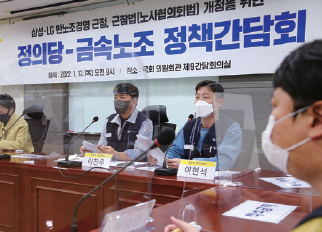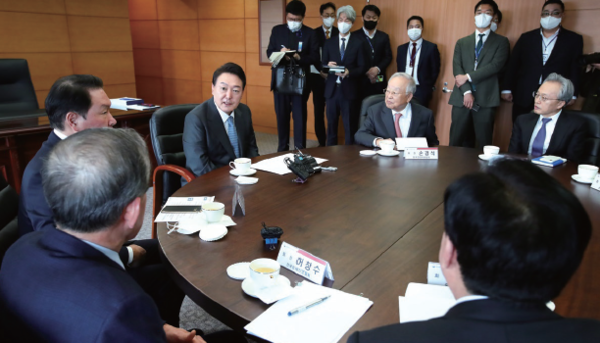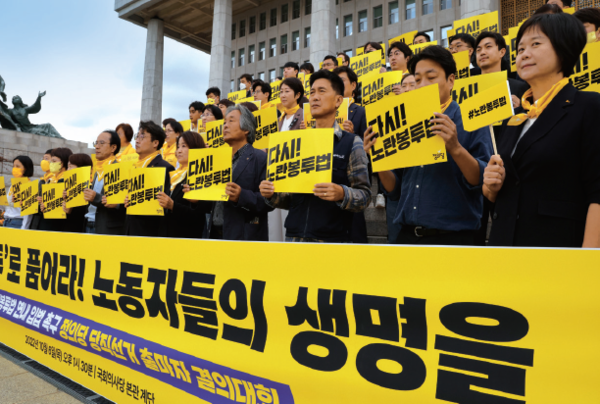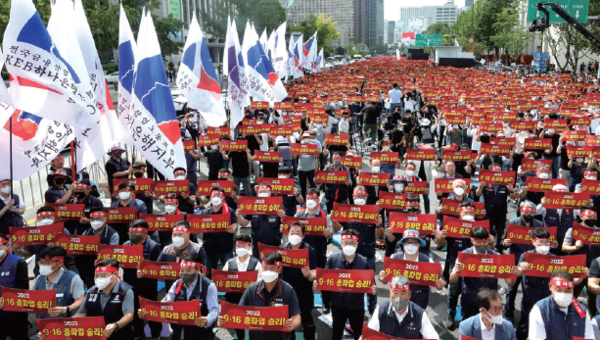The Yellow Envelope Act, a revision of the Trade Union and Labor Relations Adjustment Act (Trade Union Act), is a matter of heated debate awaiting its plenary vote in May. While the act aims to ensure workers’ rights, it is also criticized for infringing corporate property rights. In this article, the Sungkyun Times (SKT) will introduce how the Trade Union Act is revised, opinions from its supporters and protesters, and a possible middle ground.
Opening the Envelope – What Is the Yellow Envelope Act?
Ever since its foundation, the Constitution of the Republic of Korea has stipulated three labor rights: freedom of association, the right to collective bargaining, and the right to collective action. The Trade Union Act is legislated to safeguard labor rights and codify the specifics of labor unions and industrial actions, thereby promoting equal labor relations. The government and legislature play a significant role in ensuring the three labor rights, as the relationships between employer and employee are often uneven. As a part of this effort, in September 2022, a revision to the Trade Union Act was proposed and passed its deliberation this February, and now awaits a plenary vote in May. The name “Yellow Envelope Act” originated from the 2014 incident where citizens donated money in yellow envelopes after laid-off workers at Ssangyong Automotives were required to compensate $4.7 million for participating in illegal strikes. As evident in its title, the act is a culmination of voices from labor unions and civic organizations raised through multiple labor disputes. “The Yellow Envelope Act is a landmark case of bottomup legislation,” Park Kang-san, a member of the Seoul Metropolitan Council for the Democratic Party, spoke to the SKT. “It is remarkable considering the labor union organization rate in Korea, which is only 14%.” Meanwhile, as the act mainly reflects the stance of the laborer’s movement, companies are concerned that their rights may be restricted. As a result, the conflict over the revision between the supporters and objectors is intensifying.

Controversy #1: Easing of Prerequisites for Industrial Action
The first controversy surrounding the Yellow Envelope Act is regarding the alleviation of prerequisites for conducting industrial action. The current law mandates that to engage in industrial actions, labor unions must go through an adjustment process at the labor committee. It also limits the objectives of labor protests to wages, working hours, benefits, and dismissals and only permits action to disputes that occurred during the determination of working conditions. The Yellow Envelope Act aims to lower these huddles and better guarantee rights to collective action by allowing industrial spikes from simpler disputes.

-The Supporters: The Rights of Collective Action Must Be Guaranteed
Those who support the bill argue that the present law overly restricts the freedom of joint movement, thus incriminating on the workers’ rights of collective action. Under the current act, workers are prohibited from taking industrial actions during the “determination of working conditions.” Thus, they cannot stand up against disputes outside the collective bargaining processes, such as layoff and restructuring. Councilman Park said, “The Yellow Envelope Act will remove the malicious frame on disputes, resulting in the protection of labor rights and human dignity.” Thus, the labor movement expects that by broadening the definition of industrial action, rights to collective action will be better guaranteed, eventually leading to the improvement of working conditions.
-The Objectors: The Act May Encourage Illegal Strikes
Opponents of the Yellow Envelope Act point out that the statute will lead to abuse of collective action. It is based on the idea that legalizing current illegal actions would result in the abuse of strikes. When the Yellow Envelope Act is enacted, and arbitrations like the labor committee bypasses the process, employers might be forced to comply with every demand of the employees. Moreover, they argue that insuffiient evidence supports the claim that the current law overly restricts the workers’ collective action rights. The current limitations are in full compliance with the constitution, hence stipulating how some rights can be restricted to achieve social order.
Controversy #2: Redefinition of Employment
The second controversy surrounding the Yellow Envelope Act lies in how the law defines the employer and employee. Under the current legislation, the term employee is limited only to those with direct labor contracts with the employer, leaving out those in indirect and special employment. An indirect employee refers to a person sent to work in the company apart from the one they are employed with; employees under special employment relationships refer to those who settled the contract with the subcontractor via documentation. Since the Yellow Envelope Act aims to include all those in a de facto employment contract, workers of various forms will have their rights ensured.
-The Supporters: Legal Blind Spots Must Be Removed
Currently, the law only recognizes those with direct labor contracts as employees. However, the labor movement argues that loopholes exist in cases like indirect or special employment and must be filled. The 2006 precedent of the Supreme Court of Korea well represents the argument; in the case, the court ruled that labor relationships are still valid when employers have direct control over the employees’ wages and working conditions, regardless of the employment type. To illustrate, if a person is sent to work in another company that has control over their working conditions, it can be treated as direct employment. This is because employment is established when one provides labor in exchange for currency, even without a labor contract.
-The Objectors: It May Lead to Legal Instability
Some argue that expanding the definition of employee will bring legal ambiguity and instability for subcontractors. Under the current legislation, the subcontracted employees must deal with the subcontractor to bargain with the contractor when they are dissatisfied with working conditions. In this regard, the subcontractor would be disadvantaged regardless of their intentions when the Yellow Envelope Act is passed. For example, if the labor union of the subcontractor bargains directly with the contractor and agrees upon a collective agreement, the subcontractor is bound to it as well. If the subcontractor’s labor union goes on industrial action against the contractor, the subcontractor may also suffer, despite not being the direct cause of the action.
Controversy #3: Limitations to the Compensation
The third controversy surrounding the Yellow Envelope Act is the limitation to the compensation. The current Labor Union Act allows employers to hold labor unions responsible for damages caused by illegal industrial action. Such an illegal spike is an extension of previously explained Controversies #1 and #2. As seen in Controversy #1, alleviating requirements for legal industrial action will increase the barriers for employers to file a claim. Regarding Controversy #2, broadening the definition of employment would enable subcontracted employees to take on industrial action – again implying how employers are prohibited from suing for damages. Meanwhile, the Yellow Envelope Act goes a step further by disallowing companies from compensating against unions. Additionally, the act also limited the range of assertation, depending on the union’s size and financial status.

-The Supporters: All Hail the Normalization of Compensations
The labor movement argues that the Yellow Envelope Act is fundamental to stop companies from using damage claims as weapons against workers. In the past, corporates have used claims to pressure unionized workers by seizing their property and income. For instance, in 2010, Hyundai Automotives coerced union workers to stop industrial action and deunionize in return for a withdrawal of the damage claims. The workers, who were financially strained, were left with no choice but to accept this offer. This case alone shows a stark gap between the original objective and the actual usage of damage suits, which are supposed to recompensate their losses. To summarize, employers use damage claims as a weapon to corner unionized workers. Therefore, the limits to the compensation mechanism in the Yellow Envelope Act were implemented with the purpose of putting a stop to this twisted situation.
-The Objectors: Incriminating on Employers’ Rights
On the other side, opponents of the Yellow Envelope Act cite the property rights of companies. According to 2021 research by the Korea Economic Research Institute, illegal strikes caused companies $3 billion in damages. If the requirements for legal industrial action ease and companies are disallowed from suing for damages, they could be taking unbearable losses. Furthermore, critics argue that the legislative guarantees of three labor rights are already sufficient. They claim that the current Labor Union Act, which allows labor unions to freely protest provided they follow the legally stipulated limitations, specifies balanced rights between employer and employee. Moreover, even if a damage claim is filed from an illegal strike, only a fraction of the actual damages are recognized in court; the responsibilities of the workers are already being lightened.

For a Yellow Envelope Act That Will Benefit Everyone
The International Labor Organization (ILO) has classified Korea as grade 5 out of 6 in its yearly labor rights, indicating the need to fulfill requirements in the ILO core conventions. Despite this, for the Yellow Envelope Act to achieve its desired effect, it is vital to ease the tension between the stakeholders and reach an agreement. The first step for the labor unions would be to recognize the actual practicability of their demand, as excessive requirements might ultimately harm the companies they work for. In addition, they should take into account that the objectors are not vetoing the Yellow Envelope Act to merely protect their interests and make compromises that do not impose extreme financial pressure on the employers. For example, referencing a page of the United Kingdom’s bills could be a reasonable compromise. United Kingdom labor acts allow damage claims to union groups but prohibit filling against individual members. Furthermore, if the Labor Union Act limits compensation ranges to the size of each union, it could be a satisfactory compromise for both sides. Also, employers and objectors of the revision should refrain from silencing the workers’ voices, and neither should they downplay their hardship. They must stop using damage claims as a means to oppress union members and treat all workers equally, regardless of their form of employment.
After ten long years of deliberation, the Yellow Envelope Act has finally made its way to the plenary session of the National Assembly. Yet, a heated debate has reignited. Some need the new act desperately, while some veto it with all their heart. Whether the Yellow Envelope Act will pass is uncertain. However, we can only hope that workers and employers will be able to find equality after the blinding fog from collisions has lifted.
